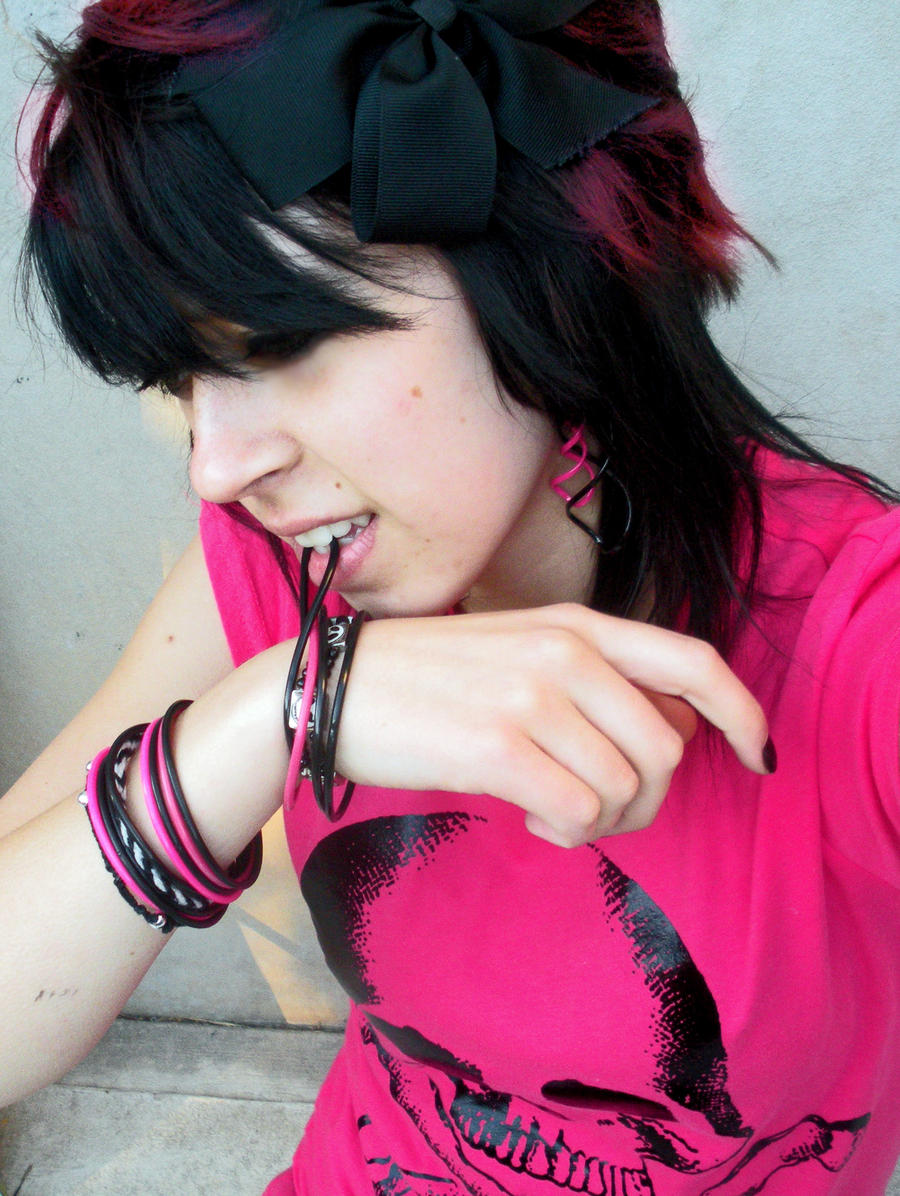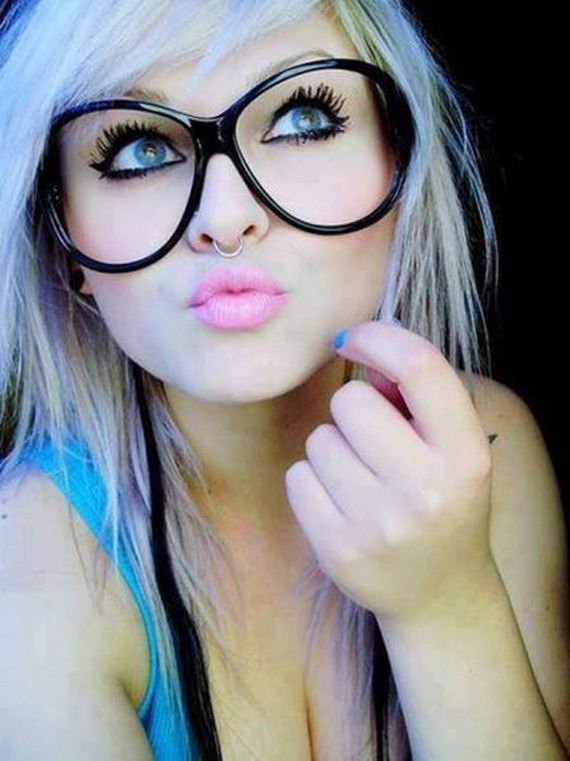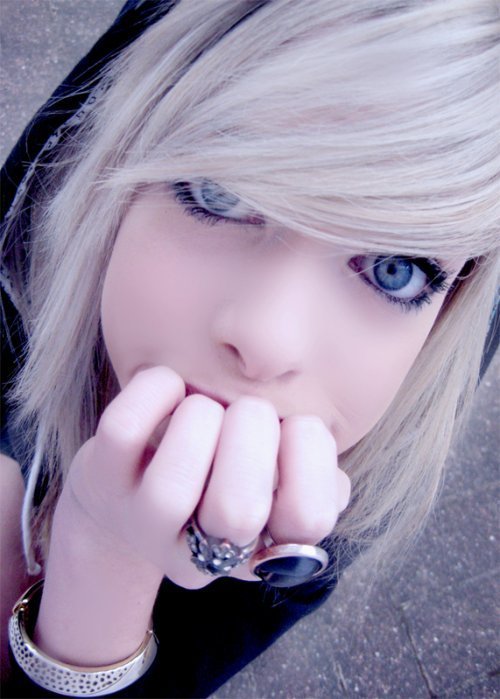Emo Girl Biography
Source(google.com.pk)
Emo /ˈiːmoʊ/ is a style of rock music characterized by melodic musicianship and expressive, often confessional lyrics. It originated in the mid-1980s hardcore punk movement of Washington, D.C., where it was known as "emotional hardcore" or "emocore" and pioneered by bands such as Rites of Spring and Embrace. As the style was echoed by contemporary American punk rock bands, its sound and meaning shifted and changed, blending with pop punk and indie rock and encapsulated in the early 1990s by groups such as Jawbreaker and Sunny Day Real Estate. By the mid-1990s numerous emo acts emerged from the Midwestern and Central United States, and several independent record labels began to specialize in the style.
Emo broke into mainstream culture in the early 2000s with the platinum-selling success of Jimmy Eat World and Dashboard Confessional and the emergence of the subgenre "screamo". In recent years the term "emo" has been applied by critics and journalists to a variety of artists, including multiplatinum acts and groups with disparate styles and sounds.
In addition to music, "emo" is often used more generally to signify a particular relationship between fans and artists, and to describe related aspects of fashion, culture, and behavior.
Emo emerged from the hardcore punk scene of early-1980s Washington, D.C., both as a reaction to the increased violence within the scene and as an extension of the personal politics espoused by Ian MacKaye of Minor Threat, who had turned the focus of the music from the community back towards the individual.[1][2] Minor Threat fan Guy Picciotto formed Rites of Spring in 1984, breaking free of hardcore's self-imposed boundaries in favor of melodic guitars, varied rhythms, and deeply personal, impassioned lyrics.[3] Many of the band's themes would become familiar tropes in later generations of emo music, including nostalgia, romantic bitterness, and poetic desperation.[4] Their performances became public emotional purges where audience members would sometimes weep.[5] MacKaye became a huge Rites of Spring fan, recording their only album and serving as their roadie, and soon formed a new band of his own called Embrace which explored similar themes of self-searching and emotional release.[6] Similar bands soon followed in connection with the "Revolution Summer" of 1985, a deliberate attempt by members of the Washington, D.C. scene to break from the rigid constraints of hardcore in favor of a renewed spirit of creativity.[2] Bands such as Gray Matter, Beefeater, Fire Party, Dag Nasty, Lunchmeat, and Kingface were connected to this movement.[2][6]
The exact origins of the term "emo" are uncertain, but date back to at least 1985. According to Andy Greenwald, author of Nothing Feels Good: Punk Rock, Teenagers, and Emo, "The origins of the term 'emo' are shrouded in mystery ... but it first came into common practice in 1985. If Minor Threat was hardcore, then Rites of Spring, with its altered focus, was emotional hardcore or emocore."[6] Michael Azerrad, author of Our Band Could Be Your Life, also traces the word's origins to this time: "The style was soon dubbed 'emo-core,' a term everyone involved bitterly detested, although the term and the approach thrived for at least another fifteen years, spawning countless bands."[7] MacKaye also traces it to 1985, attributing it to an article in Thrasher magazine referring to Embrace and other Washington, D.C. bands as "emo-core", which he called "the stupidest fucking thing I've ever heard in my entire life."[8] Other accounts attribute the term to an audience member at an Embrace show, who yelled that the band was "emocore" as an insult.[9][10] Others contend that MacKaye coined the term when he used it self-mockingly in a magazine, or that it originated with Rites of Spring.[10] The Oxford English Dictionary, however, dates the earliest usage of "emo-core" to 1992 and "emo" to 1993, with "emo" first appearing in print media in New Musical Express in 1995.[11][12]
The "emocore" label quickly spread around the Washington, D.C. punk scene and became attached to many of the bands associated with Ian MacKaye's Dischord Records label.[9] Although many of these bands simultaneously rejected the term, it stuck nonetheless. Scene veteran Jenny Toomey has recalled that "The only people who used it at first were the ones that were jealous over how big and fanatical a scene it was. [Rites of Spring] existed well before the term did and they hated it. But there was this weird moment, like when people started calling music 'grunge,' where you were using the term even though you hated it."[13]
The Washington, D.C. emo scene lasted only a few years. By 1986 most of the major bands of the movement—including Rites of Spring, Embrace, Gray Matter, and Beefeater—had broken up.[14] Even so, the ideas and aesthetics originating from the scene spread quickly across the country via a network of homemade zines, vinyl records, and hearsay.[15] According to Greenwald, the Washington, D.C. scene laid the groundwork for all subsequent incarnations of emo:
What had happened in D.C. in the mid-eighties—the shift from anger to action, from extroverted rage to internal turmoil, from an individualized mass to a mass of individuals—was in many ways a test case for the transformation of the national punk scene over the next two decades. The imagery, the power of the music, the way people responded to it, and the way the bands burned out instead of fading away—all have their origins in those first few performances by Rites of Spring. The roots of emo were laid, however unintentionally, by fifty or so people in the nation's capital. And in some ways, it was never as good and surely never as pure again. Certainly, the Washington scene was the only time "emocore" had any consensus definition as a genre.[16]
MacKaye and Piccioto, along with Rites of Spring drummer Brendan Canty, went on to form the highly influential Fugazi who, despite sometimes being connected with the term "emo", are not commonly recognized as an emo band.[17]
Today emo is commonly tied to both music and fashion as well as the emo subculture.[139] Usually among teens, the term "emo" is stereotyped with wearing jeans, sometimes in bright colors and may often be close-fitting, and T-shirts (usually short-sleeved) which often bear the names of emo bands. Studded belts and black wristbands can be associated in emo fashion. Some males can also be often wearing thick, black horn-rimmed glasses.[140][141][142]
The emo fashion is also recognized for its hairstyles. Popular looks include thin, flat and smooth hair with lots of hair on the sides and back of the head with long side-swept bangs, sometimes covering one or both eyes. Also popular is hair that is straightened or dyed black. Bright colors, such as blue, pink, red, or bleached blond, are also typical as highlights in emo hairstyles. Short, choppy layers of hair are also common.[143] This fashion has at times been characterized as a fad.[144] However, in the early 2000s, emo fashion was associated with a clean cut look instead, but changed as it spread to teens.[140] Emo fashion also has been often confused with goth fashion.[145]
Emo broke into mainstream culture in the early 2000s with the platinum-selling success of Jimmy Eat World and Dashboard Confessional and the emergence of the subgenre "screamo". In recent years the term "emo" has been applied by critics and journalists to a variety of artists, including multiplatinum acts and groups with disparate styles and sounds.
In addition to music, "emo" is often used more generally to signify a particular relationship between fans and artists, and to describe related aspects of fashion, culture, and behavior.
Emo emerged from the hardcore punk scene of early-1980s Washington, D.C., both as a reaction to the increased violence within the scene and as an extension of the personal politics espoused by Ian MacKaye of Minor Threat, who had turned the focus of the music from the community back towards the individual.[1][2] Minor Threat fan Guy Picciotto formed Rites of Spring in 1984, breaking free of hardcore's self-imposed boundaries in favor of melodic guitars, varied rhythms, and deeply personal, impassioned lyrics.[3] Many of the band's themes would become familiar tropes in later generations of emo music, including nostalgia, romantic bitterness, and poetic desperation.[4] Their performances became public emotional purges where audience members would sometimes weep.[5] MacKaye became a huge Rites of Spring fan, recording their only album and serving as their roadie, and soon formed a new band of his own called Embrace which explored similar themes of self-searching and emotional release.[6] Similar bands soon followed in connection with the "Revolution Summer" of 1985, a deliberate attempt by members of the Washington, D.C. scene to break from the rigid constraints of hardcore in favor of a renewed spirit of creativity.[2] Bands such as Gray Matter, Beefeater, Fire Party, Dag Nasty, Lunchmeat, and Kingface were connected to this movement.[2][6]
The exact origins of the term "emo" are uncertain, but date back to at least 1985. According to Andy Greenwald, author of Nothing Feels Good: Punk Rock, Teenagers, and Emo, "The origins of the term 'emo' are shrouded in mystery ... but it first came into common practice in 1985. If Minor Threat was hardcore, then Rites of Spring, with its altered focus, was emotional hardcore or emocore."[6] Michael Azerrad, author of Our Band Could Be Your Life, also traces the word's origins to this time: "The style was soon dubbed 'emo-core,' a term everyone involved bitterly detested, although the term and the approach thrived for at least another fifteen years, spawning countless bands."[7] MacKaye also traces it to 1985, attributing it to an article in Thrasher magazine referring to Embrace and other Washington, D.C. bands as "emo-core", which he called "the stupidest fucking thing I've ever heard in my entire life."[8] Other accounts attribute the term to an audience member at an Embrace show, who yelled that the band was "emocore" as an insult.[9][10] Others contend that MacKaye coined the term when he used it self-mockingly in a magazine, or that it originated with Rites of Spring.[10] The Oxford English Dictionary, however, dates the earliest usage of "emo-core" to 1992 and "emo" to 1993, with "emo" first appearing in print media in New Musical Express in 1995.[11][12]
The "emocore" label quickly spread around the Washington, D.C. punk scene and became attached to many of the bands associated with Ian MacKaye's Dischord Records label.[9] Although many of these bands simultaneously rejected the term, it stuck nonetheless. Scene veteran Jenny Toomey has recalled that "The only people who used it at first were the ones that were jealous over how big and fanatical a scene it was. [Rites of Spring] existed well before the term did and they hated it. But there was this weird moment, like when people started calling music 'grunge,' where you were using the term even though you hated it."[13]
The Washington, D.C. emo scene lasted only a few years. By 1986 most of the major bands of the movement—including Rites of Spring, Embrace, Gray Matter, and Beefeater—had broken up.[14] Even so, the ideas and aesthetics originating from the scene spread quickly across the country via a network of homemade zines, vinyl records, and hearsay.[15] According to Greenwald, the Washington, D.C. scene laid the groundwork for all subsequent incarnations of emo:
What had happened in D.C. in the mid-eighties—the shift from anger to action, from extroverted rage to internal turmoil, from an individualized mass to a mass of individuals—was in many ways a test case for the transformation of the national punk scene over the next two decades. The imagery, the power of the music, the way people responded to it, and the way the bands burned out instead of fading away—all have their origins in those first few performances by Rites of Spring. The roots of emo were laid, however unintentionally, by fifty or so people in the nation's capital. And in some ways, it was never as good and surely never as pure again. Certainly, the Washington scene was the only time "emocore" had any consensus definition as a genre.[16]
MacKaye and Piccioto, along with Rites of Spring drummer Brendan Canty, went on to form the highly influential Fugazi who, despite sometimes being connected with the term "emo", are not commonly recognized as an emo band.[17]
Today emo is commonly tied to both music and fashion as well as the emo subculture.[139] Usually among teens, the term "emo" is stereotyped with wearing jeans, sometimes in bright colors and may often be close-fitting, and T-shirts (usually short-sleeved) which often bear the names of emo bands. Studded belts and black wristbands can be associated in emo fashion. Some males can also be often wearing thick, black horn-rimmed glasses.[140][141][142]
The emo fashion is also recognized for its hairstyles. Popular looks include thin, flat and smooth hair with lots of hair on the sides and back of the head with long side-swept bangs, sometimes covering one or both eyes. Also popular is hair that is straightened or dyed black. Bright colors, such as blue, pink, red, or bleached blond, are also typical as highlights in emo hairstyles. Short, choppy layers of hair are also common.[143] This fashion has at times been characterized as a fad.[144] However, in the early 2000s, emo fashion was associated with a clean cut look instead, but changed as it spread to teens.[140] Emo fashion also has been often confused with goth fashion.[145]
Emo Girl Pictures

Emo Girl Pictures
.jpg)
Emo Girl Pictures

Emo Girl Pictures

Emo Girl Pictures

Emo Girl Pictures

Emo Girl Pictures

Emo Girl Pictures

Emo Girl Pictures

Emo Girl Pictures

South Indian School Girl Lund Chusai Pictures, Desi Girls Sucking Penis 3gp Mobile HD Video
ReplyDeleteSexy Indian Girl goes Nude Showing Big Boobs n Shaved Pussy
Matured Desi Aunty Exposing Boobs n Pussy get Fucked Pics
Sexy Indian Bhabhi Hiking Saree Showing Choot n Ass Pics
Sexy Indian Girl goes Nude Showing Big Boobs n Shaved Pussy
Sexy Indian Bhabhi Hiking Saree Showing Choot n Ass Pics
Belly Dance by Horne Arabic Belly Dancer, Arabic Sexy Belly Dancers Boobs